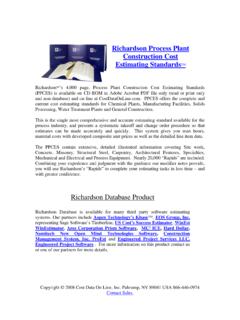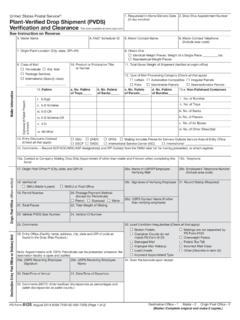Transcription of COMMON PROBLEMS OF RHODODENDRON AND …
1 Dr. Sharon M. Douglas Department of Plant Pathology and Ecology The connecticut Agricultural Experiment Station 123 Huntington Street, P. O. Box 1106. New Haven, CT 06504. Phone: (203) 974-8601. Fax: (203) 974-8502. Founded in 1875 Email: Putting science to work for society Website: COMMON PROBLEMS OF RHODODENDRON AND AZALEA. There are several diseases that commonly pinhead to those that are more diffuse or occur on rhododendrons and azaleas in even coalesce over the entire leaf. Small, landscapes and nurseries every year in black fruiting bodies may be visible on the connecticut .
2 These include fungal leaf upper or lower surfaces of the spots (Figure spots, leaf and flower gall, root rot, oedema, 3). leaf flooding, winter injury, and chlorosis. However, the occurrence and severity of these diseases are influenced by many factors, such as the level and severity of infection and overwintering inoculum from the previous year, the weather at the time of leaf emergence, cultural practices, and the species or cultivar planted. FUNGAL LEAF SPOTS. Causal Agents: Several genera of fungi ( , Cercospora, Colletotrichum, Septoria, and occasionally, Pestalotiopsis).
3 Symptoms: Many cultivars of RHODODENDRON and azalea can be infected by Figure 1. Fungal leaf spot of RHODODENDRON . one or more leaf-spotting fungi. Symptoms usually develop on current season foliage in mid to late summer. However, in some cases, infections may not be visible until the following winter or spring after infection. Leaf spots appear as dead areas of tissue scattered over the surface of the leaf. They usually have distinct margins that are often darker than the brown, black, tan, or reddish centers. Spots are usually visible on both upper and lower leaf surfaces (Figures 1 and Figure 2.)
4 Characteristic leaf spots with 2). However, the spots can vary in size from distinct margins. Tan masses of fungal spores can sometimes number of spores available to infect be seen oozing from the black fruiting emerging leaves in spring. bodies after periods of wet weather. These tendrils consist of masses of individual It is also important to follow sound cultural fungal spores that are readily wind- or rain- methods that promote plant vigor. These driven to newly emerging leaves in spring include proper watering, fertilizing, and (Figure 4). mulching, appropriately timed pruning, and managing insects, particularly the black vine weevil.
5 In some cases, leaf spots can become serious and result in injury ( , branch and twig dieback) or even plant death. This is especially problematic on new transplants or on weakened or stressed plants . In such cases, chemical control is often necessary, especially in cool, wet springs. Several fungicides are registered for use in Figure 3. Small, black fruiting structures of connecticut , including thiophanate-methyl, the fungus are visible in the leaf spots. chlorothalonil, and mancozeb. Organic options include sulfur and copper compounds. Several biological products can also be used as protectants.
6 These include Trichoderma harzianum Rifai strain KRL- AG2, Streptomyces griseoviridis strain K61, and Bacillus subtilis strain QST 713 may be effective as protectants. The pesticide labels contain information for use, including specific plant hosts and diseases, dosage rates, and safety precautions. Since most leaf-spotting fungi infect in spring as new leaves are emerging, the first fungicide spray is usually applied at bud break. Figure 4. Photomicrograph of spores of the Additional applications may also be leaf spot fungus Cercospora. necessary in unusually wet springs.
7 When symptoms are visible on the new leaves, it is Management: Fungal leaf spots can be usually too late for effective chemical managed using a variety of strategies. Leaf control. spots are rarely serious enough to warrant chemical control and are often effectively LEAF AND FLOWER GALL. managed by following good sanitary and Causal Agents: Several species of the cultural practices. In autumn, it is important fungal genus Exobasidium. to rake and remove fallen leaves from the Symptoms: Diagnostic symptoms develop vicinity of the shrub since many of the leaf- on young leaves of azaleas and occasionally spotting fungi overwinter on fallen leaves on rhododendrons in the early spring.
8 Some and plant debris. This practice reduces the of the native RHODODENDRON species (azaleas). COMMON PROBLEMS of RHODODENDRON and Azalea S. M. Douglas 2. The connecticut Agricultural Experiment Station ( ). are more susceptible than hybrid fungus overwinters in bud scales and infects rhododendrons. Leaves and buds are tender tissues as they are emerging. infected as they emerge in April and May. Affected leaves, stems, and flowers become distorted, thickened, and bladder-like. They are succulent and fleshy (Figures 5 and 6). Figure 7. An aging gall that is turning brown and shriveling.
9 Figure 5. Young, pale green, fleshy gall on Management: Leaf and flower galls are azalea. generally not serious, although they can be disconcerting, because of their eye-catching appearance. They generally do not contribute to long-term plant health issues. However, when this disease re-occurs for several consecutive years, especially on new transplants, it can reduce plant vigor. When only a few plants are involved, this disease can be managed by hand picking and discarding the galls. It is important to pick the galls before the white layer of spores appears.
10 plants growing in sites with poor air circulation or poorly drained soil are more susceptible, so anything that can be Figure 6. Older azalea leaf gall covered done to remediate these conditions can be with the white spores of the fungus. helpful in managing the disease. Galls are initially pale green in color, but Fungicide applications are generally not develop a white bloom, which consists of warranted or efficacious in home spores of the causal fungus. The galls landscapes. eventually turn red and brown and shrivel into hard masses (Figure 7).















